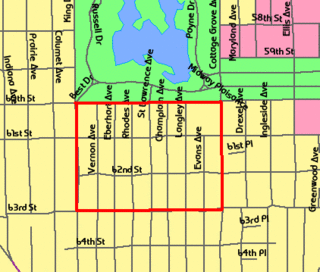
Lieutenant-Colonel John Keiller MacKay was a Canadian soldier, lawyer and jurist. MacKay served as the 19th lieutenant governor of Ontario from 1957 to 1963.

Grand Bend is a community located on the shores of Lake Huron in Southwestern Ontario, Canada. It is part of the Municipality of Lambton Shores in Lambton County.
An equitable servitude is a term used in the law of real property to describe a nonpossessory interest in land that operates much like a covenant running with the land. In England and Wales the term is defunct and in Scotland it has very long been a sub-type of the Scottish legal version of servitudes, which are what English law calls easements. However covenants and equitable servitudes in most of the jurisdictions across North America, are slightly different. The usual distinction is based on the remedy plaintiff seeks and precedent will allow for the scenario in question. Where the terms are unmerged, holders of a covenant seek money damages; holders of equitable servitudes seek injunctions. The term used to exist in England widely before Tulk v Moxhay and as byproduct of the Judicature Acts became one of the fullest mergers of equity and common law in England and Wales so as to agree initially on the term "equitable covenant", then coming to be united in the term covenant save that "equitable" bears a particular meaning in English property rights since at least 1925: it means not fully compliant with registration/written formalities. If lacks legally routine formalities it is not a full legal covenant and therefore more tenuous, often only enforceable personally and against the original covenantor.
A covenant, in its most general sense and historical sense, is a solemn promise to engage in or refrain from a specified action. Under historical English common law, a covenant was distinguished from an ordinary contract by the presence of a seal. Because the presence of a seal indicated an unusual solemnity in the promises made in a covenant, the common law would enforce a covenant even in the absence of consideration. In United States contract law, an implied covenant of good faith is presumed.
In Canadian constitutional law, the doctrine of paramountcy establishes that where there is a conflict between valid provincial and federal laws, the federal law will prevail and the provincial law will be inoperative to the extent that it conflicts with the federal law. Unlike interjurisdictional immunity, which is concerned with the scope of the federal power, paramountcy deals with the way in which that power is exercised.

In contract law, the implied covenant of good faith and fair dealing is a general presumption that the parties to a contract will deal with each other honestly, fairly, and in good faith, so as to not destroy the right of the other party or parties to receive the benefits of the contract. It is implied in a number of contract types in order to reinforce the express covenants or promises of the contract.

The Washington Park Subdivision is the name of the historic 3-city block by 4-city block subdivision in the northwest corner of the Woodlawn community area, on the South Side of Chicago in Illinois that stands in the place of the original Washington Park Race Track. The area evolved as a redevelopment of the land previously occupied by the racetrack. It was originally an exclusively white neighborhood that included residential housing, amusement parks, and beer gardens.

R v Khelawon, 2006 SCC 57 is a leading decision by the Supreme Court of Canada on the principled approach to hearsay evidence.

Loren Miller was an American journalist, civil rights activist, attorney, and judge. Miller was appointed to the Los Angeles County Superior Court by governor Edmund G. "Pat" Brown in 1964 and served until his death in 1967. Miller was a specialist in housing discrimination, whose involvement in the early stages of the Civil Rights Movement earned him a reputation as a tenacious fighter for equal housing opportunities for minorities. Miller argued some of the most historic civil rights cases ever heard before the Supreme Court of the United States. He was chief counsel before the court in the 1948 decision that led to the outlawing of racial restrictive covenants, Shelley v. Kraemer.
Beach O' Pines is a private gated community located on the shores of Lake Huron in Lambton County, Ontario, Canada. It is located immediately outside of the community of Grand Bend, Ontario, and is bordered to the northwest by Lake Huron, the southwest by the Pinery Provincial Park, the northeast by the subdivision of Southcott Pines, and the southeast by the Old Ausable Channel, Highway #21, and the subdivision of Huron Woods.
Quanta Computer, Inc. v. LG Electronics, Inc., 553 U.S. 617 (2008), is a case decided by the United States Supreme Court in which the Court reaffirmed the validity of the patent exhaustion doctrine. The decision made uncertain the continuing precedential value of a line of decisions in the Federal Circuit that had sought to limit Supreme Court exhaustion doctrine decisions to their facts and to require a so-called "rule of reason" analysis of all post-sale restrictions other than tie-ins and price fixes. In the course of restating the patent exhaustion doctrine, the Court held that it is triggered by, among other things, an authorized sale of a component when the only reasonable and intended use of the component is to engage the patent and the component substantially embodies the patented invention by embodying its essential features. The Court also overturned, in passing, that the exhaustion doctrine was limited to product claims and did not apply to method claims.
Shelley v. Kraemer, 334 U.S. 1 (1948), is a landmark United States Supreme Court case that held that racially restrictive housing covenants cannot legally be enforced.

Tulk v Moxhay is a landmark English land law case which decided that in certain cases a restrictive covenant can "run with the land" in equity. It is the reason that Leicester Square exists today.

Sun Indalex Finance, LLC v United Steelworkers, 2013 SCC 6, arising from the Ontario courts as Re Indalex Limited, is a decision of the Supreme Court of Canada that deals with the question of priorities of claims in proceedings under the Companies' Creditors Arrangement Act, and how they intersect with the fiduciary duties employers have as administrators of pension plans.

Copthorne Holdings Ltd v Canada, 2011 SCC 63, [2011] 3 SCR 721, is a decision of the Supreme Court of Canada on the applicability of the General Anti-Avoidance Rule ("GAAR") in the interpretation of the Income Tax Act (Canada). ("ITA")
Charles Augustus Tulk (1786–1849) was an English Swedenborgian and politician.
Re Drummond Wren [1945] O.R. 778 is a decision by the Ontario High Court, presided by Justice Mackay, regarding the validity of a racially motivated restrictive covenant. The Workers' Educational Association purchased the lot in East York. The covenant prohibited the land to be sold to "Jews, or persons of objectionable nationality". Drummond Wren brought forward an action to have the restrictive covenant declared invalid. Wren was the general secretary of the Workers' Educational Association. He was represented by John Cartwright and Irving Himel. J. M. Bennett appeared as legal counsel for the Canadian Jewish Congress, assisted by Bora Laskin, Jacob Finkelman, and Charles Dubin.

Southcott Estates Inc v Toronto Catholic District School Board, 2012 SCC 51, [2012] 2 SCR 675, is a landmark case of the Supreme Court of Canada in the area of commercial law, with significant impact in the areas of:
Corrigan v. Buckley, 271 U.S. 323 (1926), was a US Supreme Court case in 1926 that ruled that the racially-restrictive covenant of multiple residents on S Street NW, between 18th Street and New Hampshire Avenue, in Washington, DC, was a legally-binding document that made the selling of a house to a black family a void contract. This ruling set the precedent upholding racially restrictive covenants in Washington; soon after this ruling, racially restrictive covenants flourished around the nation. Subsequently, in Shelley v. Kraemer (1948) the court reconsidered such covenants and found that racially restrictive covenants are unenforceable.
Edward Moxhay (1787-1849) was a Victorian shoemaker, biscuit maker and property speculator, best known for his involvement in a landmark English land law case that decided that in certain cases a covenant can "run with the land".






